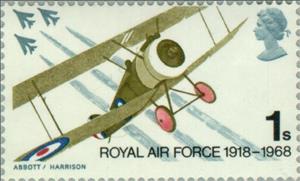Stamp: English Fighters (United Kingdom of Great Britain & Northern Ireland 1968)
English Fighters (United Kingdom of Great Britain & Northern Ireland 1968)
29 May (United Kingdom of Great Britain & Northern Ireland ) within release British Anniversaries 1968 goes into circulation Stamp English Fighters face value 1 British shilling
| Stamp English Fighters in catalogues | |
|---|---|
| Michel: | Mi:GB 487 |
| Yvert et Tellier: | Yt:GB 512 |
| Stanley Gibbons: | Sg:GB 769 |
| AFA number: | AFA:GB 483 |
Stamp is horizontal format.
Two phosphor bands 50th Anniversary of the Royal AirforceAlso in the issue British Anniversaries 1968:
- Stamp - "TUC" and Trade Unionists face value 4;
- Stamp - Votes for Women face value 9;
- Stamp - English Fighters face value 1;
- Stamp - Captain Cook's Endeavour face value 1'9;
Stamp English Fighters it reflects the thematic directions:
A vehicle (from Latin: vehiculum) is a mobile machine that transports people or cargo. Typical vehicles include wagons, bicycles, motor vehicles (motorcycles, trucks, buses), railed vehicles (trains, trams), watercraft (ships, boats), aircraft and spacecraft. Land vehicles are classified broadly by what is used to apply steering and drive forces against the ground: wheeled, tracked, railed or skied. ISO 3833-1977 is the standard, also internationally used in legislation, for road vehicles types, terms and definitions.
A military, also known collectively as an armed forces, are a heavily armed, highly organized force primarily intended for warfare. Militaries are typically authorized and maintained by a sovereign state, with their members identifiable by a distinct military uniform. They may consist of one or more military branches such as an army, navy, air force, space force, marines, or coast guard. The main task of a military is usually defined as defence of their state and its interests against external armed threats.
Aviation is the practical aspect or art of aeronautics, being the design, development, production, operation and use of aircraft, especially heavier than air aircraft. The word aviation was coined by French writer and former naval officer Gabriel La Landelle in 1863, from the verb avier (synonymous flying), itself derived from the Latin word avis ("bird") and the suffix -ation.
An aircraft is a machine that is able to fly by gaining support from the air. It counters the force of gravity by using either static lift or by using the dynamic lift of an airfoil, or in a few cases the downward thrust from jet engines. The human activity that surrounds aircraft is called aviation. Crewed aircraft are flown by an onboard pilot, but unmanned aerial vehicles may be remotely controlled or self-controlled by onboard computers. Aircraft may be classified by different criteria, such as lift type, aircraft propulsion, usage and others.
An anniversary is the date on which an event took place or an institution was founded in a previous year, and may also refer to the commemoration or celebration of that event. For example, the first event is the initial occurrence or, if planned, the inaugural of the event. One year later would be the first anniversary of that event. The word was first used for Catholic feasts to commemorate saints. Most countries celebrate national anniversaries, typically called national days. These could be the date of independence of the nation or the adoption of a new constitution or form of government. The important dates in a sitting monarch's reign may also be commemorated, an event often referred to as a "Jubilee".





